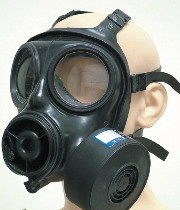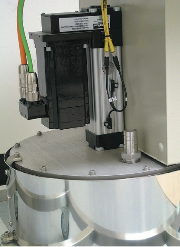
Featuring servo drives and linear actuators from Parker Hannifin, i-bodi’s computer controlled head form mimics facial expressions to test the integrity of respirator seals against the face.
The facial seal is vital to the importance of any respirator. As a result, Buckingham based i-bodi has developed an innovative computer controlled head form, designed to test the integrity of the respirator seal against the face to a level previously unachievable.
The head form mimics almost every facial expression, including talking, breathing, hyperventilating, turning and nodding. It comprises a hard skeletal base structure covered in a variable thickness silicone skin representative of the human face to produce a realistic locus surface for respirators. There are thirteen points of articulation, including nine around the lips to accurately simulate the articulatory phonetics of speech. Each of these is driven by a servo motor located within the head and driven by sophisticated software developed in-house to simulate facial movements.
This also has a mechanism to mimic a swallowing motion, actuators to produce head turn, tilt and nod movements and an articulated jaw with lower mandible jutting action – a grimace that many people make involuntarily when working under stress. These are controlled from a cabinet mounted below the head form containing three Parker Compax servodrives, SMH series servomotors and an ET Electrothrust cylinder actuator.
 Controlling movement
Controlling movement
The Compax and SMH are available in single and multiaxis variants, and in many sizes. Although typically used in handling applications, these can also be used for highly developed mechatronic systems that integrate and synchronise multiple complex motion axes. Software controls and programming tools allow rapid development of bespoke solutions. The robust ET cylinder, meanwhile, offers the precision to reproduce accuracy of movement time and time again.
James Cadogan, specialist design engineer at Parker, explained that the major drives that control the head movements had to be large enough to achieve realistic high speed of the major motions, such as shaking the head violently, heavy ragged breathing, and shouting.
He added: “The head was already full with the smaller servos, so the bigger one had to go elsewhere, hence the low level cabinet. The actuator extends into the head to transfer the power to the appropriate axis. One of our Compax units drives a large bellows, next to the control cabinet, which simulates breathing.”
The bellows form part of the DBM-01 digital breathing machine. The tests are conducted with the bellows set for ‘normal breathing’, although it can be set for moderate or heavy breathing or even panic and hyperventilating.
“The regular settings are fairly standard sinusoidal motion profiles – very commonly used in industrial applications,” adds Cadogan. “We could have just ramped up the speed for the extreme performance testing, but it would not have been particularly realistic. Instead, we wrote a non-regular pattern that included lots of sudden changes of speed and stroke – it makes the head look shockingly realistic.”
Some of the test regimes have the head conversing or reciting poetry, with others simulating violent head movements as if a person were running or climbing.
A variant of the head form can be fitted with a heavy protective helmet or a constrictive CBRN (chemical, biological, radiation, nuclear) hood; while another has the ability to make the head ‘sweat’ – tiny valves at various points around the face release variable amounts of a saline solution.
To be commercially viable, the head meets international standards including UL, CUL, CE and military spec from several different countries.
T: 00800 2727 5374
